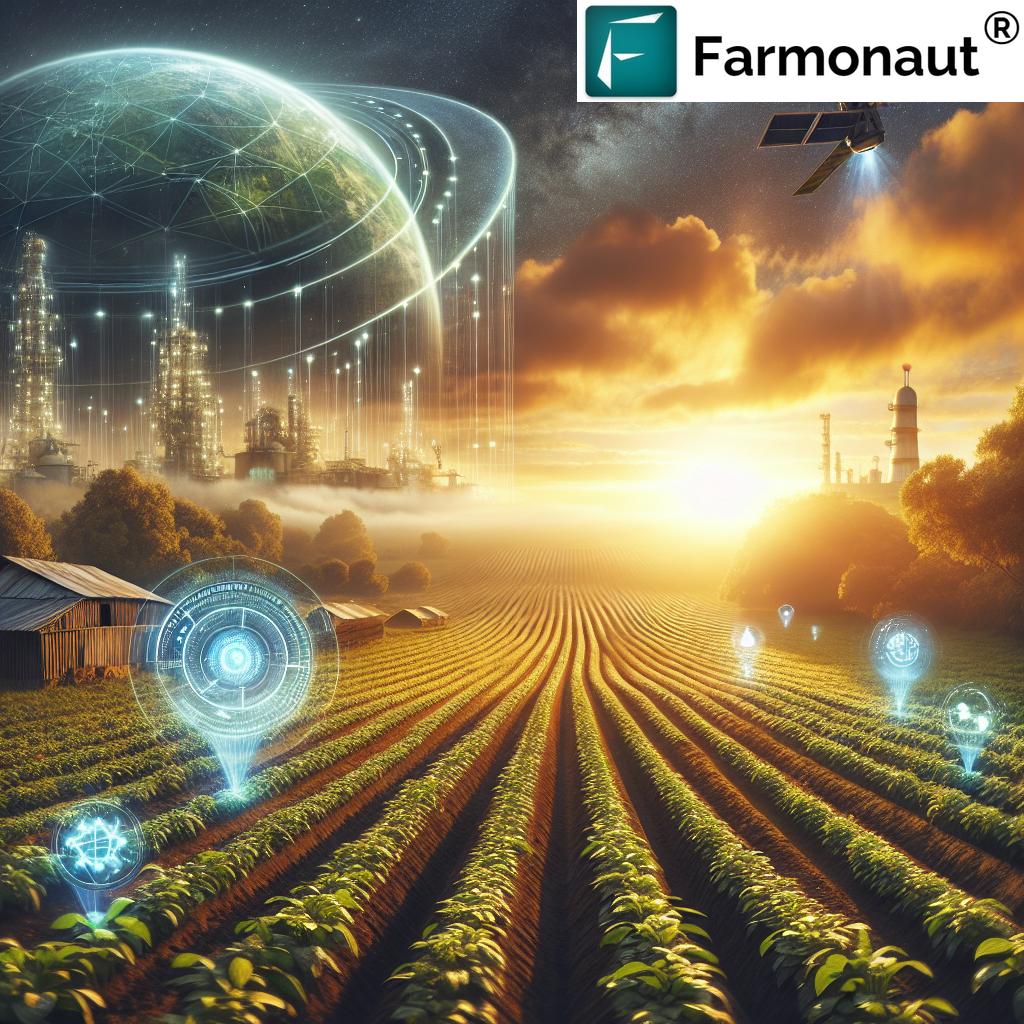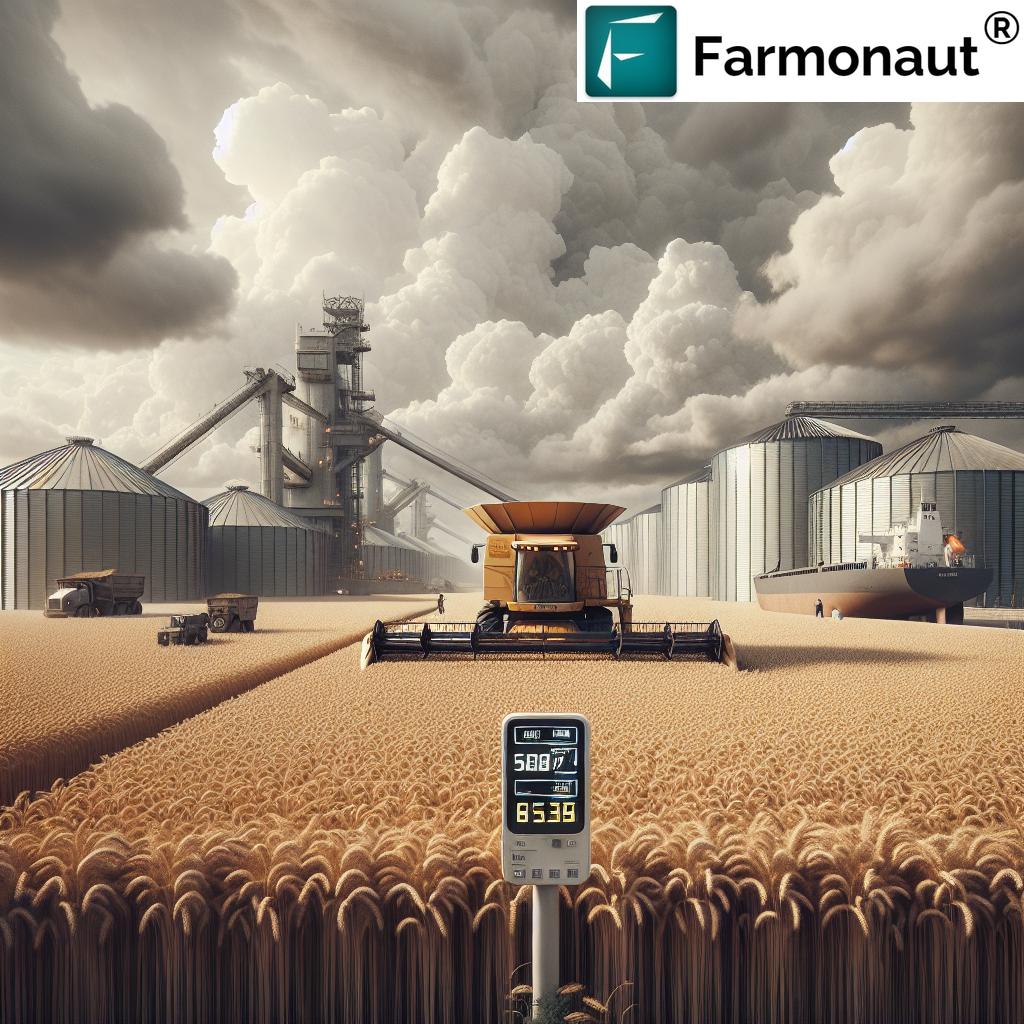Aqua Farming Tech & Aquaculture Farm Technology India 2025: Advancements Transforming Sustainable Food Production
Table of Contents
- Introduction: The Significance of Aquaculture Farm Technology in 2025
- The Role of Aquaculture in Global Food Security
- Modern Technologies Revolutionizing Aquaculture Farm Technology
- Comparison Table: Key Tech Innovations in Aquaculture 2025
- Environmental and Economic Impacts of Tech-Driven Aquaculture
- Challenges and Future Trends in Aquaculture Farm Technology India
- Farmonaut: Remote Sensing Advancements for Aquaculture and Agriculture
- Frequently Asked Questions (FAQ)
Introduction: The Significance of Aquaculture Farm Technology in 2025
Aqua farming tech and aquaculture farm technology have entered a revolutionary phase, redefining how nations like India produce sustainable seafood to meet mounting food demands. The global population, projected to surpass 8 billion by 2025, is fueling an escalated need for efficient, scalable, and environmentally conscious food production systems. Traditional fishing alone can no longer satisfy these needs. Modern technologies—from recirculating aquaculture systems (RAS) to automation, IoT monitoring, robotics, and AI—are rapidly being adopted in key regions such as India, dramatically reducing costs and environmental impacts while boosting productivity.
This article explores the most impactful advancements shaping modern aquaculture farms in 2025, their role in transforming sustainable food production, and how technologies are supporting the livelihoods of millions worldwide.
The Role of Aquaculture in Global Food Security
Aquaculture—the farming of aquatic organisms such as fish, crustaceans, mollusks, and aquatic plants—has become increasingly vital in the quest for global food security. With seafood ranked among the highest quality protein sources, aquaculture currently produces almost half of all fish consumed globally. Countries like India, armed with a combination of coastal and inland regions, have leveraged aquaculture farm technology to fulfill growing domestic demand, create rural employment, and strengthen national food security.
- By 2025, the FAO predicts overall global seafood demand will increase by 30%, with India’s aqua farming tech market projected at \$2.5B.
- Traditional fishing methods are unable to keep pace with population growth and market expansion.
- Aquaculture in India contributes significantly to nutrition, especially in nutritionally vulnerable rural populations.
Therefore, aqua farming tech emerges as a scalable alternative for sustainable seafood production, while modern aquaculture farm technology mitigates environmental concerns and reduces pressure on wild fish stocks.
Modern Technologies Revolutionizing Aquaculture Farm Technology
In 2025, aquaculture farm technology has evolved dramatically. Through innovative systems and data-driven processes, today’s aqua farms are achieving higher food yields, reducing resource consumption, and addressing the pitfalls of traditional production. Let’s explore the breakthrough technologies shaping the future of sustainable aquaculture in India and the world.
1. Recirculating Aquaculture Systems (RAS): The Foundation of Modern Aqua Farming Tech
Recirculating Aquaculture Systems (RAS) have become popular for their unique ability to recycle and filter water within tanks continuously. RAS deploys a closed-loop circuit where water is perpetually passed through a filtration and biofilter system, maintaining optimal quality vital for aquatic organisms.
- Filtration units eliminate solid waste from tanks.
- Biofilters convert ammonia (toxic) into less harmful nitrate.
- Oxygen monitoring systems track levels essential for fish health and growth.
- Water parameters (temperature, pH, dissolved oxygen) are tightly controlled for optimal productivity.
The adoption of RAS enables farms in urban or land-constrained areas to thrive, as these systems require minimal water usage and offer substantially lower environmental discharge. This approach is especially relevant within cities like Mumbai, Chennai, and Bengaluru where expansion is physically restricted.
“Advanced recirculating aquaculture systems can reduce water usage by up to 90% compared to traditional pond farming.”
2. IoT and Sensor Integration: Smarter Monitoring for Enhanced Productivity
The integration of the Internet of Things (IoT) has sparked a new era of data-driven aqua farming tech. By deploying sensors and smart devices across all stages of aquaculture farm technology, operators can now monitor and control the most crucial parameters in real time:
- Water temperature & pH: Ensuring the right growth conditions for specific fish species.
- Dissolved oxygen: Critical for fish health; IoT modules trigger automated oxygenation when levels are low.
- Ammonia and nitrate sensors: Safeguard against toxic buildup that could cause disease outbreaks.
- Remote feed systems: Automated feeders deliver accurate proportions, slashing costs and waste.
Data streams from sensors are often analyzed through cloud-based platforms, giving farmers and managers actionable insights to optimize feed schedules, anticipate health risks, and streamline entire operations.
3. Genetic Improvements and Selective Breeding: Boosting Growth and Disease Resistance
Genetic improvement and selective breeding are reshaping the landscape of aquaculture farm technology for 2025. By leveraging advanced biotechnology and gene-editing tools like CRISPR, researchers produce fish and shellfish strains with:
- Faster growth rates (shorter time-to-market).
- Higher feed conversion efficiency (lower feed costs).
- Greater disease resistance (fewer outbreaks and less need for antibiotics).
- Improved tolerance to temperature and other environmental stressors.
These genetic advances allow aqua farms to maximize production, maintain a more sustainable approach, and reduce costs associated with disease and slow growth, particularly valuable for Indian farmers tackling variable weather and water conditions.
4. Sustainable Feed Innovations: Redefining Inputs for the Future
The foundation of productive aquaculture rests on nutrient-rich feed. Yet, reliance on fishmeal and fish oil has threatened wild fish stocks and increased operational costs. In 2025, aqua farming tech is embracing sustainable feed innovations:
- Plant-based proteins (soy, wheat, rice bran) replicate essential amino acids.
- Insect meal from black soldier flies provides high protein with a minimal footprint.
- Microalgae deliver omega-3s, supporting fish health and consumer nutrition.
- Lab-formulated, cost-effective feeds cut down on waste and emissions.
These innovations reduce environmental pressure, slash costs, and ensure that aqua farms remain sustainable and resilient against supply chain shocks.
5. Automation and Robotics in Aqua Farming Tech
The deployment of automation and robotics marks a new era in aquaculture farm technology. Modern aqua farms in India and worldwide employ:
- Automated feed dispensers—ensuring precise nutrition delivery and reduced labor.
- Robotic cleaning systems—mitigating biofouling and maintaining water quality with minimal human effort.
- Underwater drones—for monitoring fish health, sampling water, and observing behavior, thus detecting early disease outbreaks.
- Harvesting robots—automating harvest and grading, improving efficiency, and reducing operational risks.
These technologies drive significant benefits in reducing costs, improving worker safety, and optimizing productivity, all while delivering consistently high quality to seafood consumers.
Comparison Table: Key Tech Innovations in Aquaculture 2025
The following table provides a comprehensive overview of the leading aquaculture farm technology and aqua farming tech innovations, their estimated adoption by 2025 in India, and quantified benefits in productivity, costs, and sustainability.
| Technology | Brief Description | Estimated Adoption Rate (India, 2025) | Estimated Productivity Increase | Estimated Cost Reduction | Sustainability Impact |
|---|---|---|---|---|---|
| IoT-based Water Monitoring | Real-time sensors track water quality parameters (temperature, pH, oxygen), allowing prompt intervention. | 65% | 25–35% | 15–18% | Prevents pollution; reduces waste and chemical use, improving environmental outcomes. |
| Automated Feeding Systems | Automated dispensers use data to optimize feed schedules and minimize waste. | 58% | 22–28% | 12–16% | Less feed waste, healthier fish, and lower carbon emissions. |
| Recirculating Aquaculture Systems (RAS) | Closed-loop water systems filtering and recycling up to 99% of farm water. | 45% | 30–40% | 20–25% | Reduces water use by up to 90%, cuts effluent, and enables eco-friendly urban farming. |
| AI-based Disease Detection | Artificial Intelligence identifies abnormal fish behavior and early disease signs from image/video. | 30% | 18–23% | 10–12% | Cuts antibiotic use; reduces mortality; enhances biosecurity. |
| Drone-based Pond Management | Aerial drones map, monitor water surface, and deploy interventions rapidly in large farms. | 22% | 15–20% | 8–10% | Improved response to environmental changes; targets treatment, reduces chemical use. |
For developers and agritech businesses looking to integrate advanced satellite-based monitoring into aquaculture, Farmonaut offers an easy-to-implement API. Get real-time crop health, water analysis, and intelligent resource management features to supercharge your farm management platform. Check out the Developer Documentation here.
Environmental and Economic Impacts of Tech-Driven Aquaculture
The adoption of advanced aquaculture farm technology strategies unlocks transformative environmental and economic impacts in 2025:
- Lower carbon footprint: By producing protein-rich seafood locally, India cuts down transportation emissions and preserves marine biodiversity.
- Waste minimization: RAS systems and precision feeding eliminate overfeeding and nutrient runoff.
- Resource optimization: Modern automation and monitoring slash water usage and energy costs—which is crucial for regions battling water scarcity.
- Rural economic support: India’s aquaculture sector provides employment and raises nutrition in many coastal and inland areas.
- Cost efficiencies: Data-driven farming reduces variable input costs and mitigates losses from disease outbreaks.
Governments and the private sector are increasingly investing in technology transfer, local infrastructure, and capacity building to ensure maximum reach and sustainability of these new solutions.
Challenges and Future Trends in Aquaculture Farm Technology India
Despite remarkable technological advancements, Indian aqua farming tech still faces significant challenges:
- High capital costs: Modern systems (RAS, automation) require substantial initial investment.
- Disease management: Intensive farming raises risk of epizootic outbreaks, requiring vigilance and AI-based early detection.
- Regulatory compliance: Navigating permits for effluent, animal welfare, and antibiotic use can be complex.
- Access for small-scale farmers: Ensuring equitable access so rural and smallholder farmers are not left behind.
- Workforce upskilling: Operating sophisticated systems demands technical literacy.
- Data privacy and cybersecurity: IoT-enabled integrated farms must safeguard sensitive operational data.
Pioneering research into integrated multi-trophic aquaculture—where different species (e.g., carnivorous fish, filter-feeding shellfish, aquatic plants) are farmed together—offers exciting pathways for future sustainability by “recycling” nutrients and optimizing natural ecological processes.
Worried about climate and market risks for aquaculture and agriculture? Farmonaut’s satellite-driven verification system reduces fraud and streamlines access to crop loans and insurance, empowering both farmers and financial institutions with real-time remote sensing data for sustainable food production.
Farmonaut: Remote Sensing Advancements for Aquaculture and Agriculture
Farmonaut is at the forefront of satellite technology, empowering aquaculture and agriculture with reliable, affordable, and actionable real-time data in 2025 and beyond. Through our platform, we combine multi-spectral satellite imagery, artificial intelligence, and blockchain to overhaul traditional farming across India and the globe.
- Satellite-Based Monitoring: Our platform leverages multispectral satellite images to measure vegetation health (NDVI), water quality, and detect environmental anomalies for both agriculture banana farming, india cotton farming, arecanut farming, and aquaculture projects.
Want to lower your farm’s carbon impact?
Explore our carbon footprinting solutions for aquaculture and agriculture, offering real-time tracking of emissions and actionable insights to ensure sustainable and compliant food production.
- Real-Time Jeevn AI Advisory: Our unique AI tool, “Jeevn”, analyzes satellite data to deliver real-time insights, weather forecasts, and customized strategies directly to aqua and agriculture operations.
- Blockchain Traceability: We provide blockchain-based product traceability, making seafood, produce, and agri-supply chains tamper-proof and transparent from farm to table.
- Fleet & Resource Management: Farmonaut’s fleet management tools boost efficiency in aquaculture and agriculture logistics, saving costs and streamlining monitoring of equipment and workforce—scalable for farms of all sizes.
- Environmental Impact Monitoring: We support comprehensive environmental monitoring, including carbon footprint calculations essential for compliance with sustainability regulations in seafood and crop production.
Our API-first approach (see Farmonaut API) enables seamless integration of satellite monitoring into existing farm management and aquaculture solutions. Our mobile-responsive Android and iOS apps put actionable data in the hands of every farmer and agri-business, whether their focus is agriculture banana farming, india cotton farming, arecanut farming, or high-tech aquaculture operations.
Managing a large aquaculture or agriculture enterprise? Discover Farmonaut’s advanced large scale farm management suite for streamlined planning, monitoring, and compliance, fully integrated with our satellite intelligence platform!
Conclusion: Transforming the Future of Aquaculture and Sustainable Food Production
By 2025 and beyond, aqua farming tech and aquaculture farm technology are reinventing the possibilities for sustainable seafood production—especially in growth regions like India. From recirculating systems that conserve water, to IoT-driven analytics and AI-powered disease checks, these technological advancements are driving step-changes in productivity, environmental safety, and economic resilience.
While challenges persist—in investment, upskilling, and fairness—the future of aquaculture promises:
- Secure, scalable, and sustainable food supply for a growing population.
- Inclusivity for rural and smallholder farmers, protecting livelihoods and local communities.
- Smarter, data-driven farm management, integrating satellite data, blockchain, and automation for resilient production systems.
- Alignment with climate, water, and biodiversity goals, ensuring food production respects natural limits.
With continuous research, forward-thinking policy, and adoption of cutting-edge aqua farming tech, India’s aquaculture will remain a cornerstone of global food security for decades to come.
Frequently Asked Questions (FAQ): Aqua Farming Tech & Aquaculture Farm Technology India 2025
- 1. What is the main difference between traditional aquaculture and RAS?
- Recirculating Aquaculture Systems (RAS) recycle and filter water within tanks, dramatically reducing water use and environmental discharge compared to traditional pond-based farming. RAS maintains consistently optimal growth conditions and enables urban/land-constrained farming.
- 2. How does IoT improve aquaculture productivity?
- IoT devices allow real-time, remote monitoring of water quality, fish health, and environmental parameters, optimizing feeding, reducing risk of disease, and lowering operational costs.
- 3. Is aquaculture sustainable for India’s water-scarce regions?
- Yes. Advanced technologies such as RAS minimize water consumption by 80–90%, making intensive fish farming feasible in water-stressed states.
- 4. What challenges do small-scale farmers face when adopting aqua farming tech?
- Barriers include high upfront costs, lack of technical knowledge, and limited access to finance. Bridging the gap requires government incentives, training programs, and affordable tech solutions.
- 5. Can satellite and AI tools be used for aquaculture as well as agriculture banana farming, india cotton farming, or arecanut farming?
- Absolutely. Tools like Farmonaut’s satellite-based monitoring and AI-driven advisory can optimize resource use, monitor crop/fish health, predict outbreaks, and support better yields across aquaculture and major crops.
- 6. How will aquaculture contribute to food security in 2025 and beyond?
- By providing a reliable, locally produced, high-protein food source, aquaculture can meet growing seafood demand, support rural livelihoods, and help India and the world achieve national nutrition and security goals.













